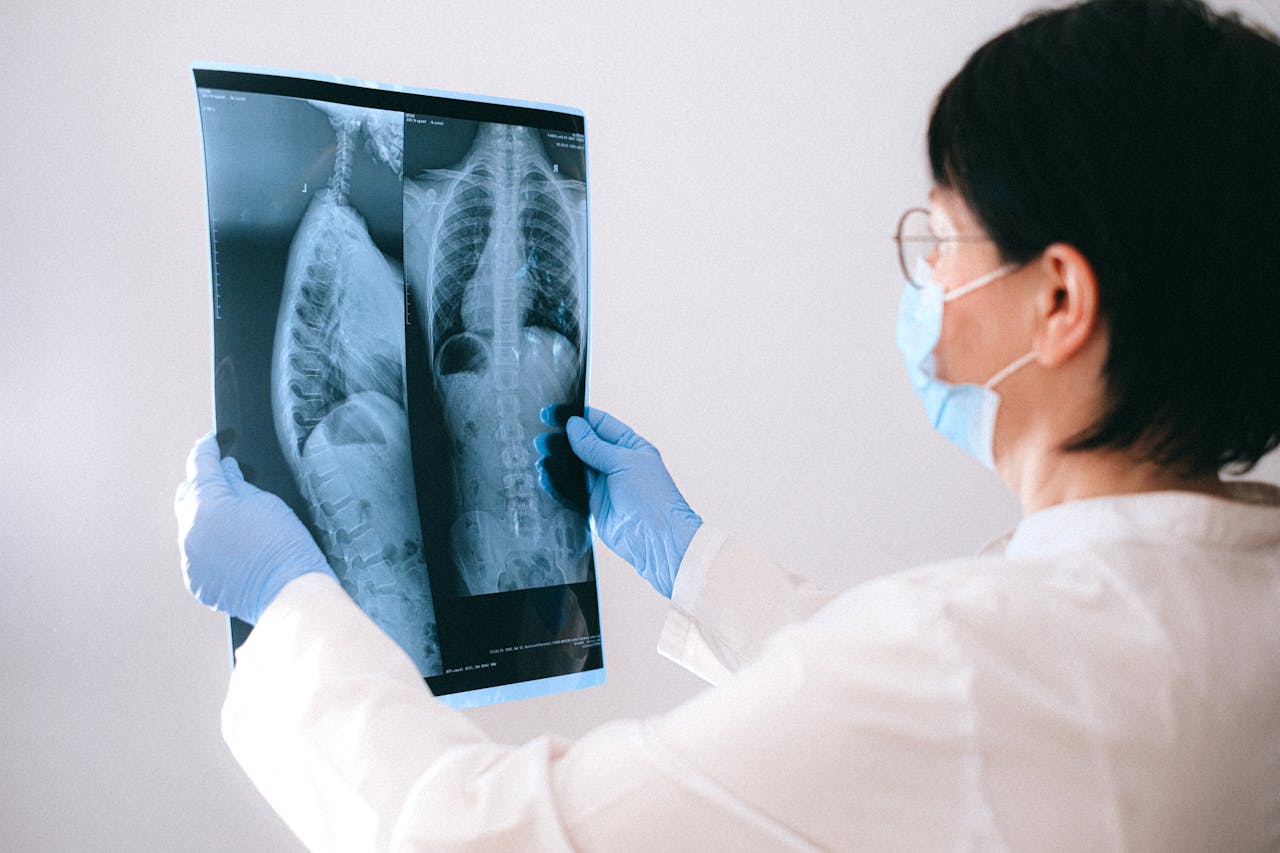
Table of Contents
The sympathetic nervous system is responsible for the fight-or-flight response, the body’s reaction to dangerous or stressful situations. It prioritizes getting out of the situation safely by increasing blood flow and oxygen to the heart and muscles and shutting down other bodily functions.
Key Takeaways
- Definition: The sympathetic nervous system (SNS) is located within the autonomic nervous system, responsible for the fight-or-flight response.
- Functions: It increases blood flow, oxygen, and energy supplies to the heart and muscles while decreasing non-essential functions, using chemicals called neurotransmitters.
- Conditions: Overactivity can lead to chronic stress and other sympathetic nervous system conditions; underactivity can cause orthostatic hypotension.
- Interaction: The sympathetic nervous system occurs in conjunction with the immune system to manage stress responses.
- Mechanism: Uses neurotransmitters like norepinephrine and epinephrine to relay signals.
What is the Sympathetic Nervous System
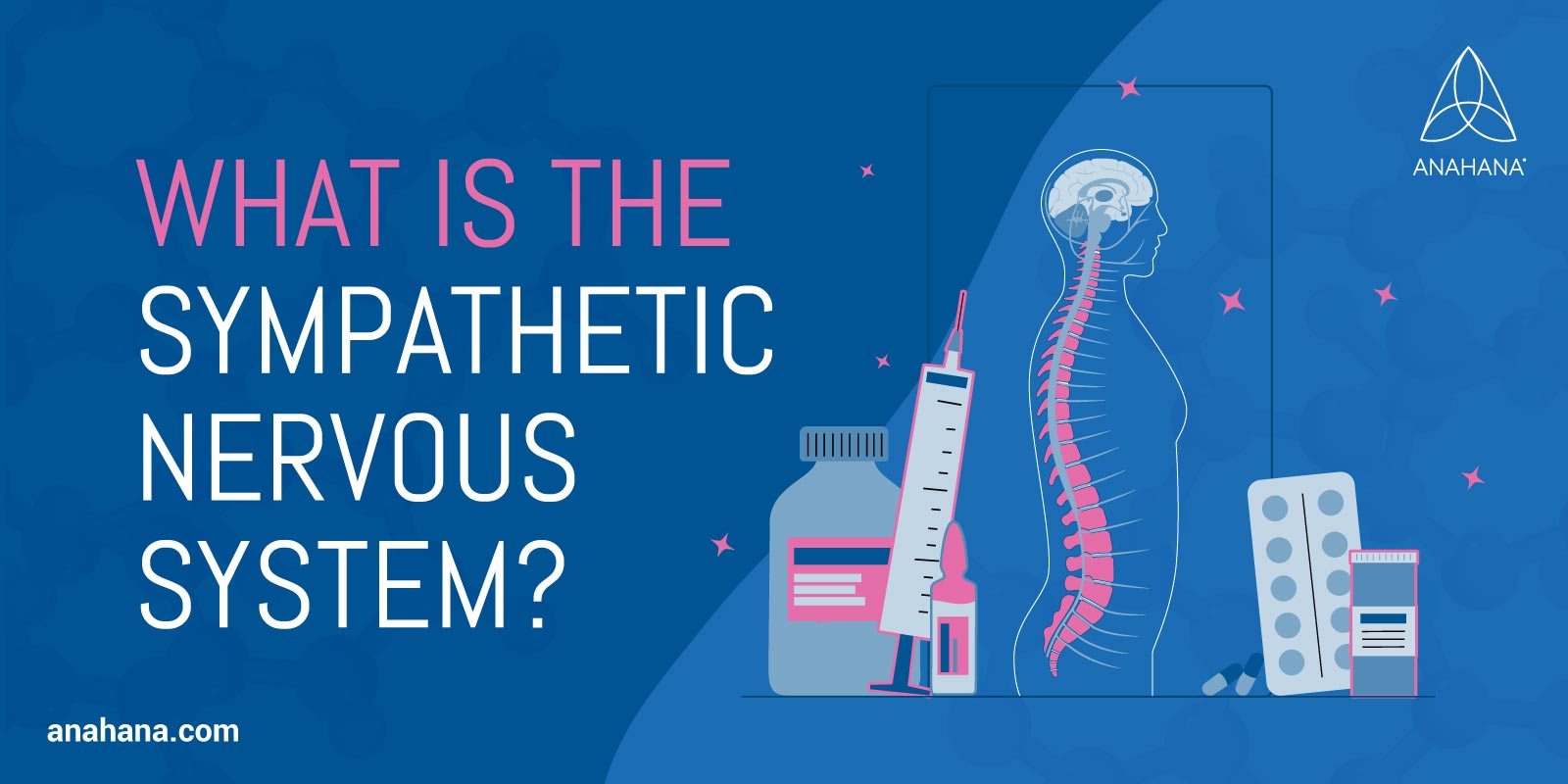 The sympathetic nervous system is a division of the autonomic nervous system, which controls the body’s involuntary functions. They are both parts of the peripheral nervous system, which comprises all nerves outside the brain and spinal cord, the central nervous system.
The sympathetic nervous system is a division of the autonomic nervous system, which controls the body’s involuntary functions. They are both parts of the peripheral nervous system, which comprises all nerves outside the brain and spinal cord, the central nervous system.
The autonomic nervous system also contains the parasympathetic nervous system. The parasympathetic system is responsible for the rest-and-digest response, which is more active during safety and rest. The sympathetic and parasympathetic systems act in a reciprocal, or seesaw, fashion. Activation of one inhibits the other, but they usually act in the body simultaneously to maintain homeostasis, a stable internal environment.
Sympathetic Nervous System Functions & Targets
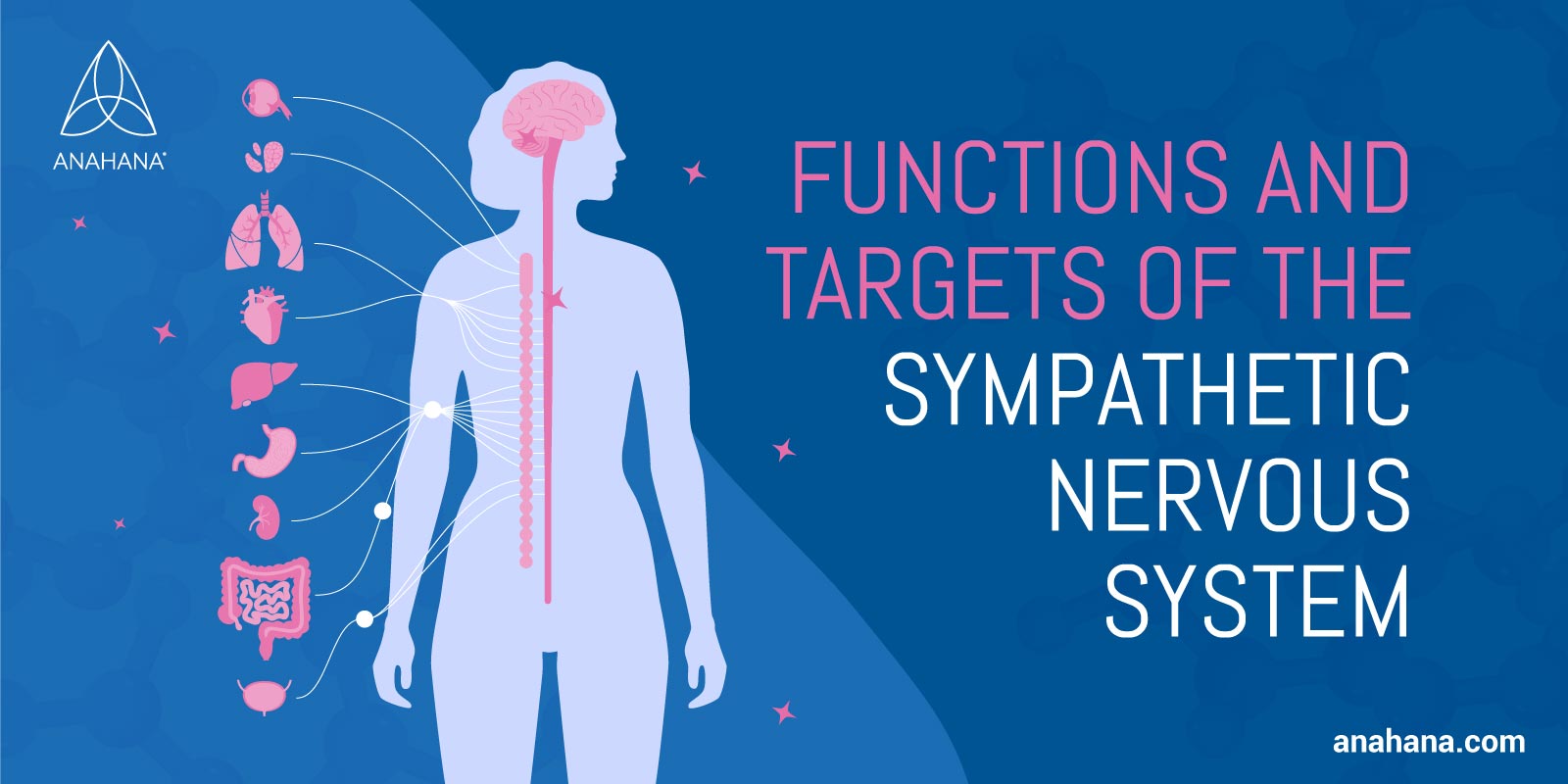 The sympathetic nervous system innervates almost every organ system to support the body’s increased physical demands during stressful situations. Sympathetic stimulation primarily increases blood, oxygen, and energy supplies to the heart and skeletal muscles. The other functions generally decrease bodily processes that may waste time or energy. Examples of sympathetic nervous system activity include:
The sympathetic nervous system innervates almost every organ system to support the body’s increased physical demands during stressful situations. Sympathetic stimulation primarily increases blood, oxygen, and energy supplies to the heart and skeletal muscles. The other functions generally decrease bodily processes that may waste time or energy. Examples of sympathetic nervous system activity include:
- Eyes: Eye muscles cause pupil dilation to improve long-range vision.
- Lungs: The airways dilate to bring in more oxygen.
- Cardiovascular System: The heart beats faster and harder to pump more blood. Most blood vessels constrict, but those in the heart and skeletal muscles dilate. This increases blood pressure and redirects oxygen-rich blood to the heart and skeletal muscle.
- Metabolic System: The body converts stored glucose and lipids into energy. It inhibits insulin secretion to inhibit new glucose storage and keep blood sugar available for energy metabolism.
- Digestive System: Digestive functions, such as gastric motility and enzyme secretion, decrease to inhibit digestion.
- Urinary System: The bladder muscle dilates, and the urethral sphincter contracts to prevent urination.
- Body Temperature Regulation: Sweat glands become more active, and piloerector muscles cause hairs to stand up. This cools the body.
- Immune System: Sympathetic innervation can up-regulate and down-regulate inflammation.
Many functions of the sympathetic nervous system directly oppose the parasympathetic nervous system. For example, parasympathetic activation lowers heart rate and blood pressure and stimulates digestive functions. Although sympathetic activation is dominant in dangerous or stressful situations, the two systems usually act in balance.
Anatomy of the Sympathetic Nervous System
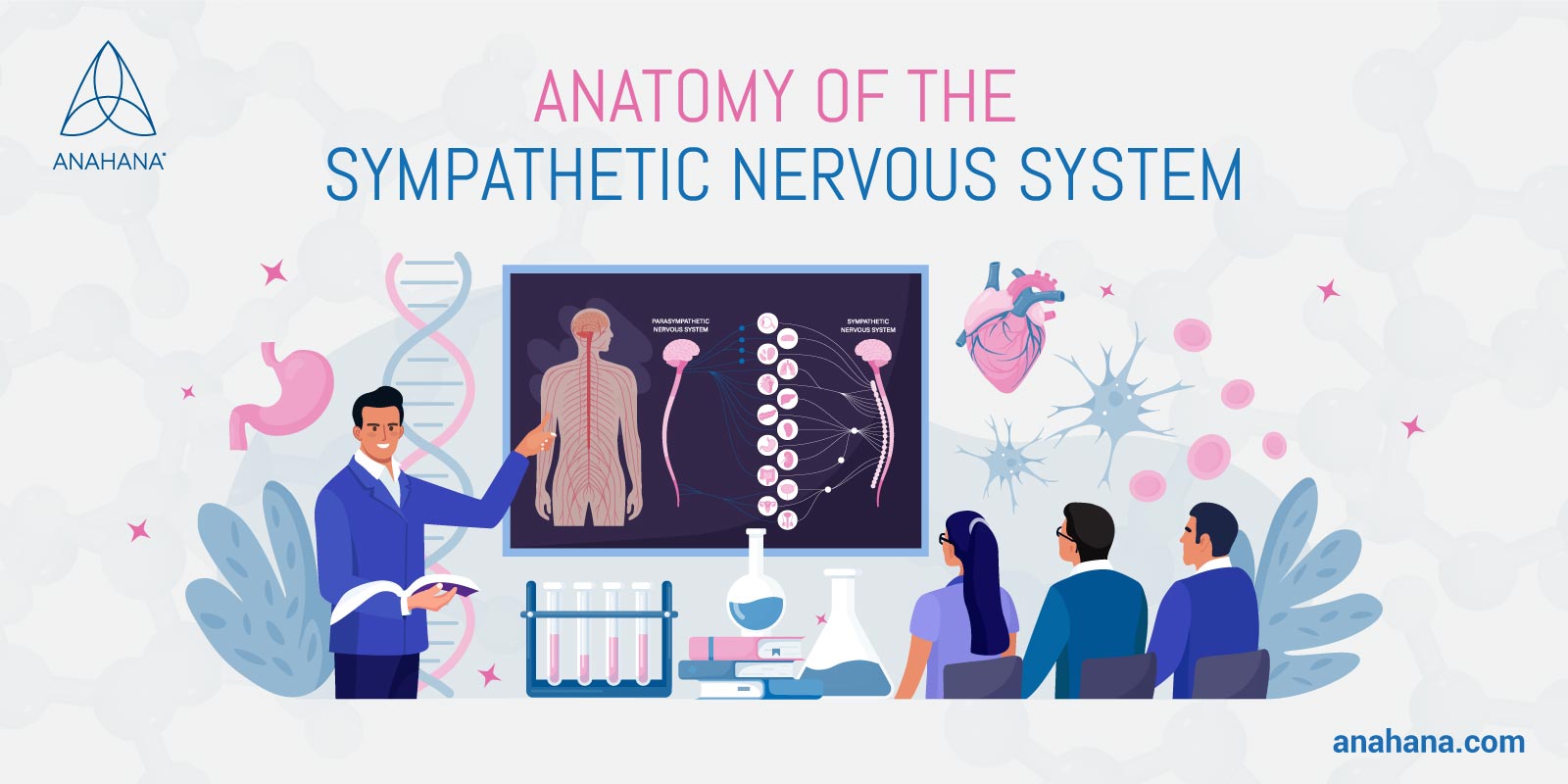 Sympathetic nerve fibers can be sensory (afferent) or motor (efferent). Sensory nerves bring information from the periphery to the brain and spinal cord, and motor nerves transmit the response back to the target organs and tissues. The sympathetic and parasympathetic systems share sensory nerves, but each has different motor nerves.
Sympathetic nerve fibers can be sensory (afferent) or motor (efferent). Sensory nerves bring information from the periphery to the brain and spinal cord, and motor nerves transmit the response back to the target organs and tissues. The sympathetic and parasympathetic systems share sensory nerves, but each has different motor nerves.
Autonomic Sensory Nerves
Receptors throughout the body monitor how well the autonomic nervous system meets the body’s physiological demands. Afferent fibers carry the sensory input back to the brain and spinal cord. The central nervous system signals any necessary changes through autonomic efferent nerves, adjusting the balance between the autonomic nervous systems.
For example, baroreceptors in the blood vessels sense blood pressure. If it needs to rise to support a fight-or-flight response, the brain increases sympathetic outflow to constrict blood vessels and decreases parasympathetic activity.
Sympathetic Motor Nerves
Motor nerves in the autonomic nervous system follow a unique two-neuron arrangement. First, preganglionic neurons carry the signal out from the central nervous system. They transmit the impulses to clusters of nerve cell bodies called ganglia. Second, postganglionic neurons receive the signal from the ganglia and deliver it to the target tissues.
Sympathetic preganglionic neurons originate from the T1 to L2 spinal nerves. Spinal nerves branch directly from the spinal cord, in this case, the thoracic and lumbar regions. Preganglionic sympathetic nerves are relatively short because sympathetic ganglia lie very close to the spinal cord.
Ganglia are the clustered cell bodies of postganglionic neurons. The long axons of postganglionic neurons are what we call postganglionic fibers. Ganglia relay the nerve impulse from the preganglionic to postganglionic nerves.
The sympathetic postganglionic fibers are longer compared to the preganglionic fibers and travel from near the spinal cord to targets in many organ systems. However, they are also thin and unmyelinated, which means they lack the insulating sheath found on some nerve fibers.
Neurotransmitters Transmit Nerve Impulses
Neurotransmitters are a group of chemical signaling molecules that transmit impulses from one nerve fiber to the next. In the sympathetic nervous system, neurotransmitters relay signals from the preganglionic nerves to the ganglia and from the postganglionic nerves to the target tissues.
Preganglionic sympathetic fibers use acetylcholine, a common neurotransmitter throughout the body. The parasympathetic nervous system also uses acetylcholine as both the preganglionic and postganglionic neurotransmitter.
The sympathetic system only uses acetylcholine as the postganglionic neurotransmitter when signaling to the sweat glands. Most postganglionic sympathetic fibers use norepinephrine, which is related to epinephrine.
Epinephrine, or adrenaline, is also a sympathetic postganglionic neurotransmitter. Special chromaffin cells in the adrenal medulla release epinephrine into the veins to stimulate system-wide sympathetic activation. The adrenal medulla is part of the adrenal glands, which sit on top of the kidneys.
What Problems Can Occur in the Sympathetic Nervous System?
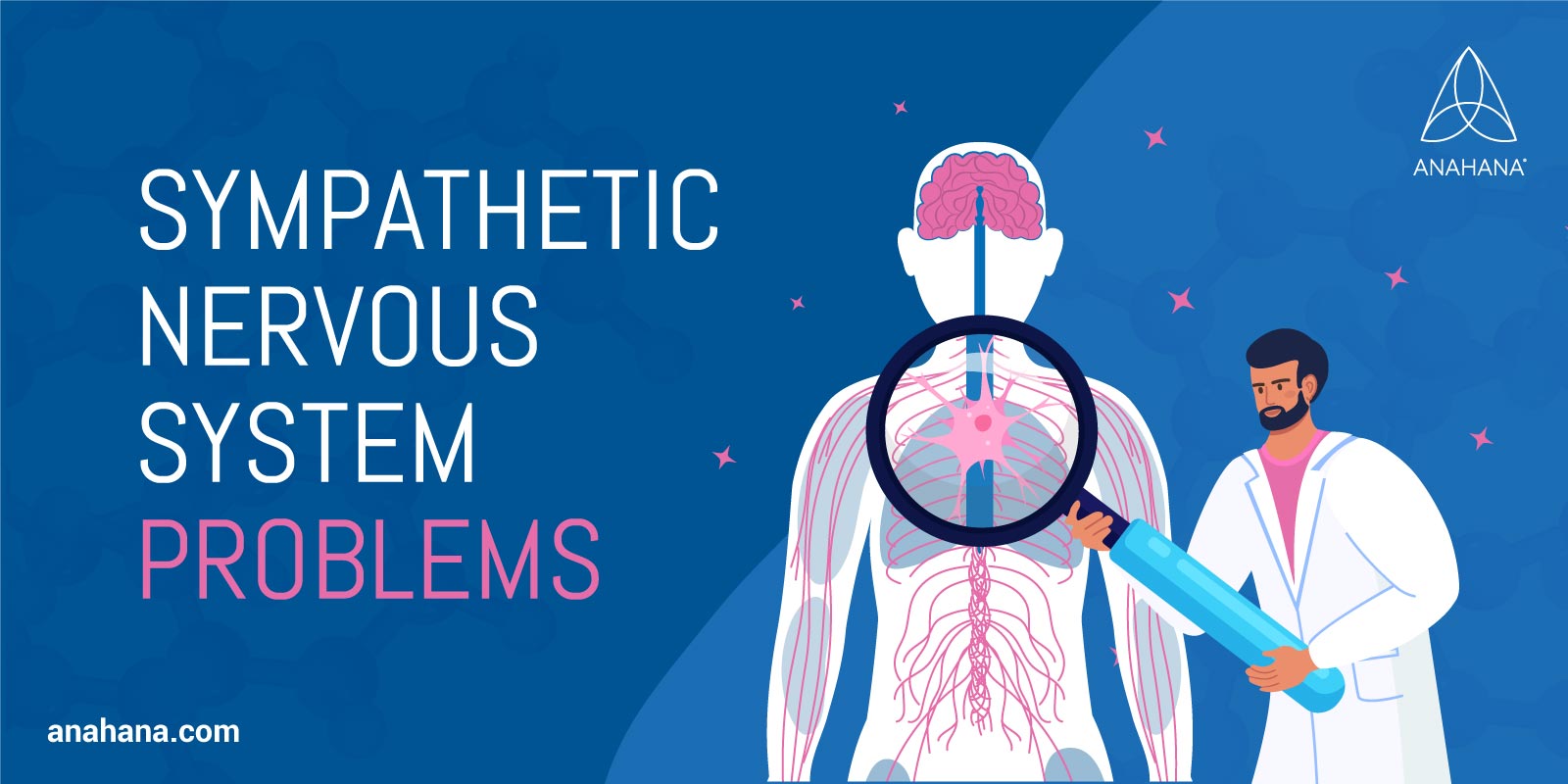 Dysregulation of the sympathetic nervous system can involve underactivity or overactivity. The body fails to adapt to stress or danger if it is underactive. If it is overactive, it inhibits parasympathetic activity, and the body fails to perform routine maintenance functions.
Dysregulation of the sympathetic nervous system can involve underactivity or overactivity. The body fails to adapt to stress or danger if it is underactive. If it is overactive, it inhibits parasympathetic activity, and the body fails to perform routine maintenance functions.
When the sympathetic nervous system is underactive, this often manifests in orthostatic hypotension. Orthostatic hypotension is a condition in which blood pressure drops suddenly when a person stands up after sitting or lying down. The sympathetic system fails to increase the blood pressure fast enough to compensate for the increased gravity, which may lead to dizziness or fainting.
Most long-term problems with sympathetic dysfunction come from an overactive sympathetic nervous system. The body is persistently in fight-or-flight mode, so it experiences chronically high blood pressure, heart rate, and blood sugar, among other issues. Long-term, this may lead to cardiovascular disorders and obesity, and eventually, even type 2 diabetes and heart failure.
Causes of Sympathetic Dysfunction
Sympathetic dysfunction may be due to many causes, including genetic conditions, injuries, infections, and lifestyle factors. Sometimes, sympathetic activity changes can be due to parasympathetic dysregulation since the two systems typically act in a seesaw fashion.
An unhealthy diet is a serious contributor to sympathetic overactivity. Overeating and high-fat, high-sugar diets trigger the excess secretion of leptin and insulin hormones, which activate the sympathetic nervous system. Insulin clears glucose from the blood by allowing it to enter cells for storage, and leptin suppresses hunger. The body becomes resistant to leptin and insulin levels when they are chronically high, which can lead to obesity and type 2 diabetes, respectively. This resistance also leads to chronically high sympathetic activity.
Another cause of sympathetic overactivity is oxidative stress in the neurons. Oxidative stress is damage caused by free radicals, or reactive oxygen species (ROS). ROS are a natural by-product of oxygen metabolism, and our bodies usually produce enough natural antioxidants to prevent damage. Excess leptin in the body can increase ROS levels and cause oxidative stress, stimulating increased sympathetic activity.
Finally, chronic stress is also a major cause of sympathetic overactivity. Chronic stress may accumulate from many sources, so reducing or eliminating stressors is crucial. The sympathetic nervous system can also become overactive with aging.
How Can I Take Care of My Sympathetic Nervous System?
Our bodies tend to be in fight-or-flight mode more than necessary, so we generally want to focus on reducing sympathetic activity. We can achieve this by targeting the sympathetic system directly or increasing parasympathetic activity to shift the balance in the autonomic nervous system.
In individuals who struggle with obesity and unhealthy diets, research suggests that the most effective way to lower sympathetic activity is to lose weight via a combination of a hypocaloric diet and moderate-intensity exercise. These strategies may not be appropriate for everyone and should be done in consultation with a doctor.
A recent study found that expressing support to others may also help reduce sympathetic activity and buffer the stress response. Participants spent five minutes writing a letter of support to a close friend or family member, while a control group spent the time writing about their commute to work or school. Next, they underwent a stress activity in which they had to write and perform five-minute speeches, then complete a mental arithmetic challenge.
The study found that the support-writing participants had a smaller spike in sympathetic biomarkers during the stress test than the control group. However, this measure fell short of statistical significance. The support group also had significantly lower systolic blood pressure measurements under stress than the control group. This suggests lower sympathetic activity or higher parasympathetic activity. The benefit of support-giving on sympathetic activity requires additional research, but it may shift our stress response away from sympathetic dominance.
The research into buffering stress responses is more robust from a parasympathetic viewpoint. Studies have shown that we can shift our autonomic nervous system to favor parasympathetic activity and reduce sympathetic activity through moderate-intensity exercise, massage, meditation, and yoga.
Frequently Asked Questions

What is the sympathetic nervous system?
The sympathetic nervous system controls the body’s fight-or-flight response. It is more active during stress or danger and helps get us out of the situation safely. It is a division of the autonomic nervous system, which controls the body’s involuntary physiologic processes.
What is the difference between sympathetic and parasympathetic?
The sympathetic nervous system controls fight-or-flight, while the parasympathetic nervous system controls the rest-and-digest response. The parasympathetic system is also part of the autonomic nervous system and has a similar structure to the sympathetic system. The two divisions work together in a seesaw fashion and usually balance each other out.
What do preganglionic, postganglionic, and ganglia mean?
Preganglionic neurons are the first step in sympathetic innervation. They carry the signal from the spinal nerves to the sympathetic ganglia. Ganglia are clusters of nerve cell bodies that relay the signal from preganglionic to postganglionic nerves. Postganglionic neurons are the second step in sympathetic innervation and deliver the signal to the internal organs.
If sympathetic activation prevents urination, why do some people pee when scared?
Under normal circumstances, the bladder is under the control of the pontine micturition center (PMC) of the brainstem. When the bladder is full, the PMC wants to stimulate urination. The conscious part of the brain holds back this urge until we reach the bathroom.
When the fight-or-flight response kicks in, the sympathetic nervous system takes over bladder control from the PMC. It is possible that during this transition, the sympathetic system knocks out communication between the PMC and the conscious part of the brain. If the bladder is full, the PMC briefly has free range to allow urination before sympathetic inhibition takes hold.
What can damage the sympathetic nervous system?
Many sources may cause sympathetic damage, including genetic disorders, injuries, and other illnesses. Lifestyle factors that can damage the sympathetic nervous system include chronic stress, unhealthy diet, lack of exercise, and oxidative stress.
How can I protect my sympathetic nervous system?
We are generally in fight-or-flight mode more than necessary, so we want to reduce sympathetic activity and increase parasympathetic activity. Some strategies include maintaining a healthy diet, moderate-intensity exercise, yoga, and meditation.
Resources
https://www.ncbi.nlm.nih.gov/books/NBK538516/
https://www.ncbi.nlm.nih.gov/books/NBK539845/
https://iopscience.iop.org/article/10.1088/1361-6579/aa6782
https://www.ncbi.nlm.nih.gov/books/NBK542195/
https://www.ncbi.nlm.nih.gov/pmc/articles/PMC6423215/
https://www.ncbi.nlm.nih.gov/pmc/articles/PMC4430650/
https://escholarship.org/uc/item/3hv9d1k2
https://www.ncbi.nlm.nih.gov/books/NBK557419/
Disclaimer
The contents of this article are provided for informational purposes only and are not intended to substitute for professional medical advice, diagnosis, or treatment. It is always recommended to consult with a qualified healthcare provider before making any health-related changes or if you have any questions or concerns about your health. Anahana is not liable for any errors, omissions, or consequences that may occur from using the information provided.

By: Emma Lee
Emma is an editor for Anahana and a soon-to-be graduate of the Master of Science program at the University of Toronto. She graduated with a Bachelor’s in Neuroscience and Immunology at the University of Toronto and has extensive experience in research. She is passionate about learning the science behind health and wellness and hopes to contribute her knowledge to help people live healthier lives. Outside of Anahana, Emma enjoys exploring nature, playing with her dog, and doing arts and crafts.